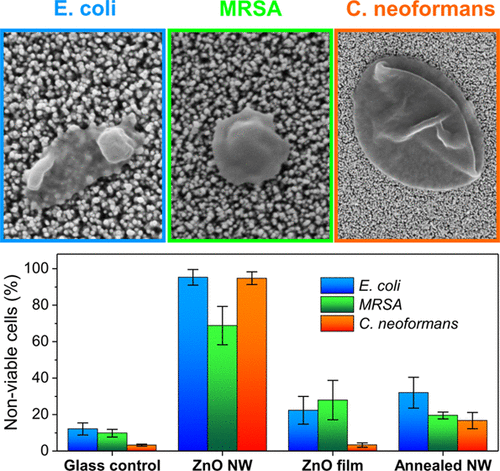当前位置:
X-MOL 学术
›
ACS Appl. Bio Mater.
›
论文详情
Our official English website, www.x-mol.net, welcomes your
feedback! (Note: you will need to create a separate account there.)
Significant Enhancement of Antimicrobial Activity in Oxygen-Deficient Zinc Oxide Nanowires
ACS Applied Bio Materials ( IF 4.6 ) Pub Date : 2020-04-04 , DOI: 10.1021/acsabm.0c00065 Aaron Elbourne 1 , Samuel Cheeseman 1 , Pierce Wainer 1 , Jaewon Kim 1 , Alexander E Medvedev 2 , Kylie J Boyce 3 , Christopher F McConville 1 , Joel van Embden 1 , Russell J Crawford 1 , James Chapman 1 , Vi Khanh Truong 1 , Enrico Della Gaspera 1
ACS Applied Bio Materials ( IF 4.6 ) Pub Date : 2020-04-04 , DOI: 10.1021/acsabm.0c00065 Aaron Elbourne 1 , Samuel Cheeseman 1 , Pierce Wainer 1 , Jaewon Kim 1 , Alexander E Medvedev 2 , Kylie J Boyce 3 , Christopher F McConville 1 , Joel van Embden 1 , Russell J Crawford 1 , James Chapman 1 , Vi Khanh Truong 1 , Enrico Della Gaspera 1
Affiliation

|
The fabrication of antimicrobial surfaces that exhibit enhanced activity toward a large variety of microbial species is one of the major challenges of our time. In fact, the negative effects associated with both bacterial and fungal infections are enormous, especially considering that many microbial species are developing resistance to known antibiotics. In this work, we show how a combination of a specific surface morphology and surface chemistry can create a surface that exhibits nearly 100% antimicrobial activity toward both Gram-negative and Gram-positive bacteria and fungal cells. Arrays of vertically aligned, oxygen-deficient zinc oxide (ZnO) nanowires grown on a substrate exhibit enhanced antimicrobial activity compared with surfaces containing either less defective nanowires or highly oxygen-deficient flat films. This synergistic effect between physical activity (morphology) and chemical activity (surface composition) has been shown to be responsible for the outstanding antimicrobial activity of our surfaces, especially toward notoriously resilient bacterial or fungal species. These findings provide a series of design rules for tuning the activities of antibacterial and antifungal nanomaterials. These rules constitute an excellent platform for the development of next-generation antimicrobial surfaces.
中文翻译:

显着增强缺氧氧化锌纳米线的抗菌活性
制造对多种微生物物种表现出增强活性的抗菌表面是我们这个时代的主要挑战之一。事实上,与细菌和真菌感染相关的负面影响是巨大的,特别是考虑到许多微生物物种正在对已知的抗生素产生耐药性。在这项工作中,我们展示了特定表面形态和表面化学的组合如何产生对革兰氏阴性和革兰氏阳性细菌和真菌细胞表现出近 100% 抗菌活性的表面。与含有缺陷较少的纳米线或高度缺氧的平面薄膜的表面相比,在基板上生长的垂直排列的缺氧氧化锌 (ZnO) 纳米线阵列表现出增强的抗菌活性。物理活性(形态)和化学活性(表面组成)之间的这种协同效应已被证明是我们表面出色的抗菌活性的原因,特别是对众所周知的弹性细菌或真菌物种。这些发现为调整抗菌和抗真菌纳米材料的活性提供了一系列设计规则。这些规则构成了开发下一代抗菌表面的绝佳平台。
更新日期:2020-04-04
中文翻译:

显着增强缺氧氧化锌纳米线的抗菌活性
制造对多种微生物物种表现出增强活性的抗菌表面是我们这个时代的主要挑战之一。事实上,与细菌和真菌感染相关的负面影响是巨大的,特别是考虑到许多微生物物种正在对已知的抗生素产生耐药性。在这项工作中,我们展示了特定表面形态和表面化学的组合如何产生对革兰氏阴性和革兰氏阳性细菌和真菌细胞表现出近 100% 抗菌活性的表面。与含有缺陷较少的纳米线或高度缺氧的平面薄膜的表面相比,在基板上生长的垂直排列的缺氧氧化锌 (ZnO) 纳米线阵列表现出增强的抗菌活性。物理活性(形态)和化学活性(表面组成)之间的这种协同效应已被证明是我们表面出色的抗菌活性的原因,特别是对众所周知的弹性细菌或真菌物种。这些发现为调整抗菌和抗真菌纳米材料的活性提供了一系列设计规则。这些规则构成了开发下一代抗菌表面的绝佳平台。











































 京公网安备 11010802027423号
京公网安备 11010802027423号